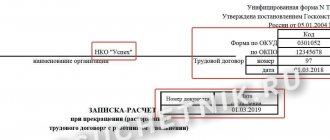The structure of all government institutions has its own divisions, departments, that is, structural units. And most of them have separate divisions - branches and representative offices, including in other cities. And sometimes employers need to transfer employees from one department to another, from the head office to a branch, etc. In some cases, for example, when staffing is reduced, the employer is obliged to offer the employee a vacant position from those available both directly in the organization and in the branch. In the article we will look at how to transfer an employee to another structural unit, including a separate one and located in a different area.
The concept of a structural unit
First, let's figure out what a structural unit of an organization is. Neither labor nor civil legislation provides an “official” definition. In the generally accepted sense, a structural unit of an organization is its officially designated part that performs certain tasks established by the organization.
At the same time, there is a term “separate division”. To such divisions of Art. 55 of the Civil Code of the Russian Federation includes branches and representative offices. A representative office is a separate division of a legal entity, located outside its location, which represents the interests of the legal entity and protects them. A branch is a separate division of a legal entity located outside its location and performing all or part of its functions, including the functions of a representative office.
Representative offices and branches are not legal entities. They are endowed with property by the legal entity that created them and act on the basis of the provisions approved by it.
By virtue of clause 16 of the Resolution of the Plenum of the Armed Forces of the Russian Federation dated March 17, 2004 No. 2 “On the application by the courts of the Russian Federation of the Labor Code of the Russian Federation” (hereinafter referred to as Resolution of the Armed Forces of the Russian Federation No. 2), branches and representative offices belong to the structural divisions of the organization. These are also other structures of the organization - its departments, services, workshops, sections, etc. Each structural unit has its own name and is reflected in the organization’s staffing table.
Accordingly, the organization has internal structural units (sections, departments) and there may be separate structural units (branches and representative offices), which can be located either in the same area with the employer or in another.
The Labor Code also mentions other separate divisions that are not branches and representative offices. And here we turn to tax legislation. A separate division of an organization is any division territorially isolated from it, at the location of which stationary workplaces are equipped. Recognition of a separate division of an organization as such is carried out regardless of whether its creation is reflected or not reflected in the constituent or other organizational and administrative documents of the organization, and on the powers vested in the specified division. The territorial isolation of a unit from an organization is determined by an address that differs from the address of this organization.
I know how to correctly... transfer an employee from branch to branch
“I work as a human resources inspector in one of the branches of a large organization. According to the Regulations on the branch, our director selects personnel, concludes employment contracts with new employees, signs orders for personnel, dismisses employees - in general, resolves all personnel issues in the branch.
I have never had any problems with the preparation of personnel documents. And here’s the problem: one of our employees is moving with her family to another region, where our organization also has a branch. Now she is asking to be transferred to this branch to fill a vacant position. The director of our branch does not object.
But how to arrange everything? Should I fire her by transferring her to another branch or issue an order to transfer her to another permanent job? And most importantly, who should issue the transfer order: the director of our branch or the director of the branch to which the employee asks to transfer her? Please help me figure it out."
About how to arrange the transfer of an employee from one branch to another, we asked someone who knows 100% how...
First of all, let's find out whether there are any peculiarities of conducting personnel records in an organization that has several separate structural divisions.
Office work in organizations with separate structural divisions
It must be said that in accordance with paragraph 3 of Art. 55 of the Civil Code of the Russian Federation (hereinafter referred to as the Civil Code of the Russian Federation), branches and representative offices are separate divisions that are not legal entities.
A branch is a separate division of a legal entity located outside its location and performing all or part of its functions, including the functions of a representative office. Representative offices and branches are not legal entities. They are endowed with the property of the legal entity that created them and act on the basis of the provisions approved by it (clauses 2 and 3 of Article 55 of the Civil Code of the Russian Federation).
The head of a separate division is appointed by the head of the organization and acts on the basis of the power of attorney issued to him.
Considering that in your organization, the heads of branches are vested with the authority to hire and fire employees, as well as resolve other issues related to labor relations, without the participation of the head of the organization, we can say that the organization provides for a decentralized form of personnel records management.
Even if a structural unit is granted rights and responsibilities in the field of drawing up personnel documents, it should be taken into account that the head of a separate unit is authorized to resolve personnel issues only within the boundaries of his unit.
EXAMPLE
Thus, the director of a branch has the right to hire employees, transfer them to another job in the branch and resolve issues of termination of labor relations on various grounds.
IT IS FORBIDDEN!
Dismiss an employee by transfer from one branch to another under clause 5, part 1, art. 77 Labor Code of the Russian Federation
As we see, transferring an employee from one branch to another goes beyond such authority. This is the difficulty of making a decision on translation and the procedure for processing it.
Neither the director of the branch where the employee currently works, nor the head of the department to which the employee will be transferred to another job with his consent, has the authority to make a decision on the transfer and draw up the necessary personnel documents.
Obviously, in our situation only the head of the organization has such powers.
So, we found out that a branch is not an independent legal entity, but has its own specifics compared to other structural divisions.
In order for an employee to work in another branch, she must be transferred to another permanent job according to the rules provided for in Art. 72 of the Labor Code of the Russian Federation, but taking into account certain features.
Let's see how personnel documents should be drawn up in this case.
Preparation of personnel documents
Considering that in the situation under consideration in the organization, personnel records management is decentralized, personnel documents are drawn up, apparently, in the parent organization, where employee documents are received from one branch, and then transferred for further management and storage to another branch.
We offer the following procedure for transferring an employee to another permanent job from one branch to another.
Stage 1 Filling out an application for transfer of an employee to another branch
In our situation, the employee himself asks to be transferred to another job in another branch. It is advisable that such a request be made in writing. Since the decision to transfer to another separate structural unit is made by the head of the organization, the application is drawn up in his name (example 2).
Our information
Conducting personnel records in organizations with separate structural divisions is not regulated by regulations. This issue is within the competence of the head of the organization and should be resolved at the local level.
We can distinguish three forms of organizing personnel records management in organizations that have separate divisions in their structure.
Form 1. Centralized office work - all processing of personnel documents is concentrated (centralized) in a single center - the personnel service of the parent organization.
Form 2. Decentralized records management - personnel records management is distributed between the parent organization and separate structural associations that have a relatively identical set of functions for personnel document flow.
At the same time, the personnel service of the parent organization can draw up personnel documents for all employees of the organization, including employees of separate divisions, and in a branch or representative office only documents of employees of these divisions are stored and processed.
Form 3.
“Mixed” office work involves both centralized processing of personnel documents (for example, registration of employment, termination of an employment contract) and decentralized (for example, imposition of disciplinary sanctions on employees, storage of personal files). The division is usually made according to various personnel functions - part belongs to the parent organization, part is transferred to a separate unit.
OUR ADVICE
Specify in a local regulatory act, for example in the Instructions for Personnel Records Management, the procedure for processing personnel documents when transferring an employee from one separate division to another, as well as the procedure for transferring for further maintenance and storage of personnel documents, the procedure for transferring work books, etc. (example 1)
In practice, the completed application will most likely be transferred to the parent organization through the head of a separate division, who, in turn, also decides on the possibility of transferring an employee from his branch. The application of a branch employee can be sent to the parent organization with a covering letter (example 3).
To the head of the organization in order to make a decision on the merits
request, you will need to find out the opinion of the head of the branch to which the transfer is intended.
The question arises: why is such a tripartite agreement needed if in any case the decision on the transfer will be made by the head of the organization? We believe that such a procedure should be followed, at least so that the head of the branch where the employee wishes to transfer knows that such a transfer will be carried out, and does not accept an employee “from the street” to the vacant position. To approve the transfer, a letter can be sent to the branch (example 4).
After all the necessary approvals, the head of the organization makes a decision on processing the transfer (example 5).
Stage 2 Transfer of employee documents from the branch to the parent organization
So, the head of the organization decided to formalize the transfer; for this, the employee’s documents are transferred to the personnel service of the parent organization.
In practice, the transfer of documents can be done by mail, by certified or registered mail, or in person by personnel service employees. The most reliable, undoubtedly, will be the personal transfer of documents.
It is advisable to accompany the transfer of documents from the branch and their receipt at the parent organization with the appropriate act (example 6).
IN THE SAME TIME..
...there is an erroneous opinion that the transfer of an employee from one separate division to another is formalized by dismissing the employee in the order of transfer on the basis provided for in paragraph 5 of Part 1 of Art. 77 of the Labor Code of the Russian Federation (hereinafter referred to as the Labor Code of the Russian Federation).
Let us remind you that separate divisions are not independent legal entities, and an employee, when transferred from branch to branch, continues to work for the same employer. Therefore, it would be illegal to dismiss an employee in this case, since there are no grounds for terminating the employment contract.
We are talking about a transfer to another job with the same employer (to another unit for the same position or to another), which is carried out with certain features determined by the territorial isolation of the units.
Stage 3 Drawing up an additional agreement to the employee’s employment contract
Next, the parent organization draws up an additional agreement to the employee’s employment contract, which reflects all the new conditions associated with work in another separate structural unit (example 7).
Stage 4 Issuing an order to transfer to another permanent job
The transfer of an employee to another permanent job is formalized by issuing an order (instruction) in a unified form No. T-5 (approved by Resolution of the State Statistics Committee of Russia dated January 5, 2004 No. 1 “Approval of unified forms of primary accounting documentation for the accounting of labor and its payment”; hereinafter referred to as the resolution No. 1) (example 8).
Stage 5 Transfer of employee documents from the parent organization to the branch
After the additional agreement and transfer order are drawn up, the employee’s documents are transferred for further maintenance and storage to the branch where the employee will work. Thus, the work book, the employee’s personal card, a copy of the order for transfer to another job, an additional agreement to the employment contract and a personal file (if maintained) are transferred to the branch.
Stage 6 Making an entry about the transfer to another permanent job in the employee’s work book
Information about transfer to another permanent job must be entered in the employee’s work book (Part 4 of Article 66 of the Labor Code of the Russian Federation). We believe that such an entry can be made in the employee’s work book at the branch where the transfer was made.
An entry about a transfer to another permanent job is entered into the work book as follows: in column 1 the serial number of the entry is entered; Column 2 indicates the date of the employee’s transfer; in column 3 an entry is made about the employee’s transfer to another job, indicating the position, structural unit, name of the separate structural unit; in column 4, reference is made to the order (instruction) to transfer the employee to another job (example 9).
Stage 7 Entering an entry about the transfer into the employee’s personal card
In accordance with clause 12 of the Rules, the employer is obliged to familiarize the owner with the entry made in the work book about transfer to another permanent job against signature in his personal card, where the entry made in the work book is repeated.
After entering information about the employee’s transfer to another permanent job into Section III “Hiring, transfers to another job” of form No. T-2, the employer familiarizes them with the information to the employee against signature in column 6 “Personal signature of the owner of the work record book” (example 10).
Stage 8 Conducting labor safety briefings
In accordance with Part 2 of Art. 225 of the Labor Code of the Russian Federation, for workers transferred to another job, the employer or a person authorized by him is obliged to provide instructions on labor protection, organize training in safe methods and techniques for performing work and providing first aid to victims.
Not forget!
Make an entry in the employee’s work book about transfer to another permanent job
Before starting work, the employee should be given initial training at the new workplace. Training is usually carried out by an occupational safety specialist or an employee assigned these responsibilities.
Thus, the transfer of employees from one branch to another is carried out according to the general rules provided for the transfer of an employee from one structural unit to another. At the same time, the peculiarities of documenting such a transfer directly depend on the form of organization of personnel records established in the company.
Example 1
Instructions for personnel records management (fragment)
Example 2
Employee's application for transfer to another branch
Example 3
Letter from the branch to the parent organization
Example 4
Letter from the parent organization to the branch
Example 5
Employee's application for transfer to another branch
Example 6
Act on the transfer of employee documents from the branch to the parent organization
Example 7
Additional agreement to the employment contract on the transfer of an employee to another permanent job from branch to branch
Example 8
Order to transfer an employee to another permanent job from branch to branch (Form No. T-5)
Example 9
Making an entry in the employee’s work book about transfer to another permanent job from branch to branch
Example 10
Employee personal card (form No. T-2) (fragment)
Magazine: Everything for the personnel officer, As of: 04/13/2012, Year: 2012, Issue: No. 5 Andreeva Valentina Ivanovna
Source: https://hr-portal.ru/article/ya-znayu-kak-pravilno-perevesti-rabotnika-iz-filiala-v-filial
Place of work in the employment contract
Speaking about structural units, it is necessary to decide on such a condition of the employment contract as the place of work. In accordance with Art. 57 of the Labor Code of the Russian Federation, the employment contract must indicate the place of work, and in the case when an employee is hired to work in a branch, representative office or other separate structural unit of the organization located in another area, the place of work indicating the separate unit and its location.
It is not specified what is meant by the term “place of work”. Therefore, someone indicates the name of the organization, someone a city or other locality, and someone the exact address.
The Presidium of the Armed Forces of the Russian Federation in the Review of the practice of consideration by courts of cases related to the implementation of labor activities by citizens in the regions of the Far North and equivalent areas (approved on February 26, 2014), in this regard, explained that in the theory of labor law, a place of work is understood as located in a certain locality (settlement) a specific organization, its representative office, branch, other separate structural unit. If the organization and its separate structural unit are located in different areas, based on Part 2 of Art. 57 of the Labor Code of the Russian Federation, the employee’s place of work is specified in relation to this unit.
If we turn to clause 2 of Art. 54 of the Civil Code of the Russian Federation - the location of a legal entity is determined by the place of its state registration on the territory of the Russian Federation by indicating the name of the locality (municipal entity).
And based on the Letter of the Ministry of Labor of the Russian Federation dated November 17, 2017 No. 14 2/B-1012, as a condition on the place of work, the name of the employing organization is prescribed in the employment contract, containing an indication of the organizational and legal form.
We can conclude that it is necessary to include in the employment contract the address where the employees are located not in the condition of the place of work, but in the condition of the workplace, since the workplace is the place where the employee must be or where he needs to arrive in connection with his work and which is directly or indirectly under the control of the employer (Part 6 of Article 209 of the Labor Code of the Russian Federation). Since the workplace is an additional condition of the employment contract, it may or may not be included in it.
As a place of work, the employment contract should indicate the name of the employer and an indication of its location (location in a specific locality). For example: “The Employee’s place of work is the State Budgetary Healthcare Institution “Central Regional Hospital No. 1” (GBUZ Central District Hospital No. 1), Kstovo, Nizhny Novgorod Region.”
Transfer to a structural unit located within the same area
Let us remind you that transfer to another job is recognized as:
- permanent or temporary change in the labor function of the employee and (or) the structural unit in which he works (if the unit was specified in the employment contract), while continuing to work for the same employer;
- transfer to work in another area together with the employer (Article 72.1 of the Labor Code of the Russian Federation).
Such a transfer is carried out only with the consent of the employee.
When a separate structural unit is located in the same area as the parent organization, indicate it in the employment contract by virtue of Art. 57 of the Labor Code of the Russian Federation is not necessary. Therefore, there is no need to transfer an employee from the parent organization to such a branch or other separate division. In this case, you can arrange the transfer. This also applies to cases when an employee needs to be transferred, for example, from one department to another.
The relocation of an employee is considered to be his movement from the same employer to another workplace, to another structural unit located in the same area, assignment of work on another mechanism or unit, unless this entails a change in the terms of the employment contract determined by the parties. The employee’s consent to the move is not required (Part 3 of Article 72.1 of the Labor Code of the Russian Federation).
Thus, the transfer of an employee to a separate structural unit of the organization is considered a transfer if the following conditions are met:
- the employee’s job function does not change;
- the employee’s place of work in the employment contract does not change (remains the same, for example, Kstovo, Nizhny Novgorod region);
- the movement occurs within the administrative-territorial boundaries of the corresponding locality (clause 16 of the Resolution of the Armed Forces of the Russian Federation No. 2).
The transfer of an employee is formalized by issuing an order (instruction) from the employer, which is brought to the attention of the transferred employee against signature.
| State budgetary healthcare institution “Central District Hospital No. 1” (GBUZ Central District Hospital No. 1) Relocation Order No. 7 07/11/2019 Kstovo In connection with the change in the staffing table, taking into account the absence in the employee’s employment contract dated 02.10.2015 No. 02/10 of an indication of a structural unit as a condition of the employment contract, in accordance with Art. 72.1 of the Labor Code of the Russian Federation I ORDER: 1. To transfer nurse Tatyana Sergeevna Ivanova from the therapeutic department (building 1) to the gastroenterology department located in the same area (building 2) from July 20, 2019, without changing her job function and other terms of the employment contract dated October 2, 2015 No. 02/10. 2. The HR department specialist will familiarize the employee with this order against signature. 3. The accounting department will take into account the movement of T. S. Ivanova. 4. Entrust control over the execution of the order to the head of the personnel department, M. N. Vasilyeva. Chief physician Nikishin A.V. Nikishin The following have been familiarized with the order: Nurse Ivanova T. S. Ivanova 11.07.2019 Head of HR Department Vasilyeva M. N. Vasilyeva 11.07.2019 |
But it should be noted that even if such separate units as branches are located in the same area as the parent organization, they are usually indicated in employment contracts with employees. In these cases, a transfer is issued.
How is the transfer of an employee to a separate unit processed?
If the employee initiates the transfer, then he must write a statement addressed to his employer. If the initiator is the employer himself, then written consent will need to be obtained from the employee. Usually such consent is obtained as follows: an order is issued to transfer the employee, on which he puts o. However, notice must be given to the employee before the order is issued. To do this, the employee is sent a notice, which is drawn up in free form. On this notice, the employee expresses in writing his consent to the transfer or refuses the transfer. In the case of the latter, the employee may be dismissed for one of the following reasons:
- own wish;
- agreement of the parties;
- reduction.
Sometimes the transfer of an employee occurs on the initiative of the head of a structural unit. To do this, he must draw up an idea about the transfer of the employee, which describes the professional and business qualities of the employee, and also explains the reason for the transfer. The submission is written to the manager, who, after familiarizing himself with the document, puts a resolution on it.
Important! The transfer of an employee is accompanied by the execution of a transfer order, the basis for issuing which is amendments to the employment contract. These changes are recorded in the additional agreement.
When registering an employee’s transfer, it is necessary to clarify the term of the employment contract, since this transfer may be accompanied by changes to this term. For example, an employment relationship with an employee is term-based, but upon transfer to a new position, it becomes indefinite. In this case, you will also need to formalize a change in the type of employment contract. The reverse situation will also require the same changes.
Important! In general cases, it is impossible to change the term of the concluded employment agreement, therefore, when the nature of the employment relationship changes, it is not the transfer of the employee that is formalized, but his dismissal and rehiring.
Transfer to a branch located in another area
If an employee is initially accepted into a branch of an organization located in another locality, the place of work and the name of the branch must be indicated in the employment contract. For example: “The employee’s place of work is the Federal State Budgetary Educational Institution of Secondary Vocational Education “Volzhsky Technical School of Railway Transport” (FGBOU SPO “Volzhsky Technical School of Railway Transport” - a branch of the Federal State Budgetary Educational Institution of Higher Education “Volgograd State Transport University” (FGBOU VO VGUPS ), located in the city of Volzhsky, Volgograd region).
When an employee is offered to move to a branch located in another area, as well as when transferred from one branch to another located in another area, a transfer must be completed.
note
It is also necessary to carry out a translation when, in violation of Art. 57 of the Labor Code of the Russian Federation, a branch located in another locality is not indicated in the employment contract.
The transfer of an employee to a branch located in another area should not be confused with a transfer carried out in connection with the employer’s move to another area when the organization itself moves. In this case, employees may refuse to move with the employer and are then subject to dismissal under clause 9, part 1, art. 77 Labor Code of the Russian Federation. If an employee refuses to move to the area where the branch is located, dismissal is not provided.
But the employer will have to reimburse employees for expenses associated with moving to work in another area, as in the case of a transfer together with the employer (Articles 165, 169 of the Labor Code of the Russian Federation). Expenses covered:
- for the relocation of the employee, members of his family and transportation of property (except for cases when the employer provides him with means of transportation);
- for settling into a new place of residence.
The difference between translation and movement in a table
| Moving | Translation |
| In this case, the terms of the employment agreement, place of work and responsibilities of the employee do not change. Accordingly, when moving, the employee will not be required to obtain consent. | The work is performed in a new place, with a change in responsibilities and the nature of the work. A prerequisite for transferring is the employee’s consent to the transfer. Without consent, transfer is possible only for a separate period of time in the event of any emergency. |






